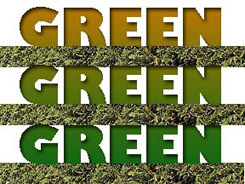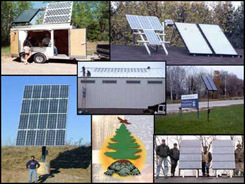
It seems as if every time we turn on the TV or radio, or open our newspaper or a magazine, there are stories encouraging us to "go green". Al Gore has warned us about global warming and most of us think we should do something. But we don't know where to start. In 2007, there were almost 300,000 community associations in the United States, representing more than 20 million homes. If each of our associations encouraged their owners to take some minor steps to conserve energy, the impact would be substantial.
If we start with the common areas of a community and initiate some of the suggestions below, think of the impact it would have. Not only would the community save energy by going green, it would save money.
For starters, we can have an energy evaluation performed by the energy provider. These are usually offered free of charge and the results can be amazing. Following are some ideas for savings at the clubhouse and around the common area.
Insulation and Weatherization
An association can reduce their heating and cooling needs by up to 30 percent by investing a few hundred dollars in proper insulation and weatherization. This is one of the easiest and most cost-efficient ways to reduce energy waste and maximize energy dollars. Insulation is measured in R-values. The higher the R- value, the better the walls and roof will resist the transfer of heat and cold. There should be a minimum of R-22 (seven inches of fiber glass or rock wool or six inches of cellulose). Most homes have between R-22 and R-49 insulation in the attic.
Weatherization tips include the installation of a rubber or foam gaskets behind outlet and switch plates. If there is a fireplace, close the damper tightly when it is not in use. Caulk, seal and weather-strip all seams, cracks and openings to the outside. Reducing air leaks can save up to ten percent of the electricity bill.
Heating and Cooling
Invest in a programmable thermostat. Don't pay to heat/cool when no one is in the clubhouse. The association can save ten percent by turning the thermostat back by ten to fifteen percent for eight hours a day. Clean or replace furnace filters once a month or as needed. Turn off ventilation fans as soon as they have done the job. In just one hour, these fans can pull out a houseful of warmed or cooled air.
Choose cleaner electricity
The single largest source of industrial air pollution in the U.S. is traditional electricity production, generated from non-renewable, polluting sources such as coal. Purchasing cleaner energy is one of the easiest things you can do to reduce your household’s share of carbon dioxide (CO2) emissions.
For more than a decade, Green Mountain Energy Company has been producing power from renewable sources like wind, which is naturally replenished and 100% pollution-free. When you switch to pollution-free electricity you can help change the way power is made!
Lighting
By replacing 25 percent of your incandescent bulbs with fluorescents, you can save about 50 percent of your lighting energy. Fluorescent lamps last six to 10 times longer and are much more efficient. Compact fluorescent lamps (CFLs) are more expensive but pay for themselves with energy savings.You can also save energy by installing photocells on outdoor lights. Exterior lighting is one of the best places to use CFLs because of their long life. In addition to the energy savings, you don't have to pay to have bulbs replaced as frequently.
Windows
In colder climates, install windows that are gas filled with low-emissivity (low e) coatings to reduce heat loss. In warmer climates, select windows with spectrally- selective coatings to reduce heat gain. In the Sun Belt, you can install new solar control spectrally-selective windows and cut the cooling load by more than half. If you decide not to install new windows, you can install storm windows and reduce heat loss by 25 to 50 percent. If you already have storm windows, be sure to repair and weatherize them for maximum effect.

Appliances
Appliances account for about 20 percent of your household's electrical consumption. An appliance has two price tags - a purchase price and the operating cost. You will be paying on that second price tag every month with your utility bill for the next 10 - 20 years. Look for the ENERGY STAR® label. You can add to the savings by following a schedule of preventive maintenance, such as replacing gaskets on refrigerators.
Landscaping
A well-placed tree, shrub or vine can provide shade and act as a windbreak. Deciduous trees planted on the south and west sides will keep the clubhouse cool in the summer and allow the sun to shine in the windows in the winter. Evergreen trees planted on the north and west sides of the clubhouse deflect winter winds. Vines growing on trellises can provide the shade for a window or the whole side of the clubhouse. Mulch stabilizes soil temperature, prevents weeds, feeds the soil for healthier plants and helps conserve water. And, it recycles itself. The use of organic or slow-release fertilizers for trees and shrubs produces plants with strong root systems and no excessive "top growth", saving you time and money. They also reduce nutrient run-off into ground and surface waters. Select plants that are pest and disease-resistant and low-water-use varities. Use soaker hoses or drip irrigation on beds to save up to 50 percent or more compared to sprinklers. Water in the morning to avoid evaporation and avoid evening watering as it can encourage the growth of mold or plant diseases. In dry periods, allow the turf to go dormant. Water once a month and it will bounce back in the fall. Deep but infrequent watering of turf will encourage a stronger root system.
Now that we have toured the common areas, let's think about informing our owners of these energy and dollar saving tips. Imagine what would happen if each of our 20 million plus owners did nothing more than switch to CFL bulbs and saved 50 percent on their lighting energy bill. These are small dollar changes that will provide savings for years to come. Let's jump on the GREEN bandwagon and do our part. One small step for an association...one giant step for planet EARTH.
 Print
Print Email
Email








